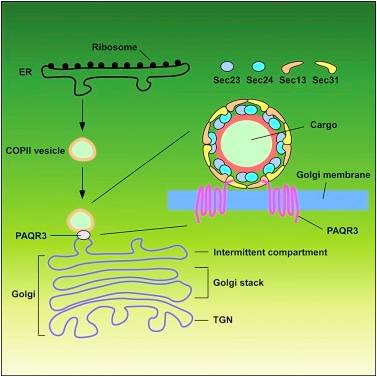Researchers Discovered a New Mechanism in the Regulation of Intracellular Vesicle Transport
Intracellular vesicle transport is essential for maintaining various physiological functions in cells and body. About one third of eukaryotic proteome traffics from endoplasmic reticulum (ER) in which the cargo is folded, modified and then transported to the Golgi apparatus. The transport of protein from endoplasmic reticulum to Golgi (ER-to-Golgi) is an important stage for protein quality control and sorting to maintaining cellular homeostasis. The ER-to-Golgi anterograde transport is driven by COPII vesicles mainly composed of a Sec23/Sec24 inner shell and a Sec13/Sec31 outer cage. How COPII vesicles are tethered to the Golgi components are not completely understood.
CAO Qianqian, a PhD student at Prof CHEN Yan's lab of Shanghai Institute of Nutrition and Health, Chinese Academy of Sciences recently found that progesterone and adiponectin receptor 3 (PAQR3) plays an important role in the transport of COPII vesicle. In the study, researchers firstly applied APEX-based proximity labeling strategy and mass spectrometry to identify 992 proteins adjacent to PAQR3 and found many of them are involved in biological processes of intracellular transport. Then, they used two model systems of ER-to-Golgi transport, i.e., GalNac-T2 and RUSH assay to analyze the mechanism and found that the transport of proteins from ER to Golgi is delayed by PAQR3 deletion. Through a series of biochemical and cellular experiments, researchers found that the N-terminal end of PAQR3 is able to interact with the WD domains of Sec13 and Sec31A. PAQR3 also enhances Golgi localization of Sec13 and Sec31A, thus revealing that PAQR3 is a new player to regulate ER-to-Golgi transport through interaction with Sec13/Sec31A coat complex of COPII vesicles.
PAQR3 mainly functions as a tumor suppressor that has an inhibitory function in many types of tumors. Considering a well-balanced and controlled intracellular trafficking is crucial in maintaining cellular homeostasis, the study indicates that the downregulation of PAQR3 found in many types of tumors is likely associated with dysregulation of cellular homeostasis due to abnormal ER-to-Golgi transport. Therefore, this finding revealed that PAQR3 plays an important role in transport of COPII vesicles not only expands our comprehension about the complexity of intracellular trafficking, but may also increases the understanding about the molecular basis of human diseases.
The work was published on November 30th on iScience, a new journal from Cell Press with the title "PAQR3regulates ER-to-Golgi trafficking of COPII vesicle via interaction with Sec13/Sec31A coat proteins". The study was aided by Professor LIAO Lujian from East China Normal University. The project was supported by grants from the National Natural Science Foundation of China, the Ministry of Science and Technology of China and the Chinese Academy of Sciences.

A Model to Depict the Function of PAQR3
(Image by Prof. CHEN Yan's Group)
Media Contact:
WANG Jin (Ms.)
Shanghai Institute of Nutrition and Health,
Chinese Academy of Sciences
Email: sibssc@sibs.ac.cn
